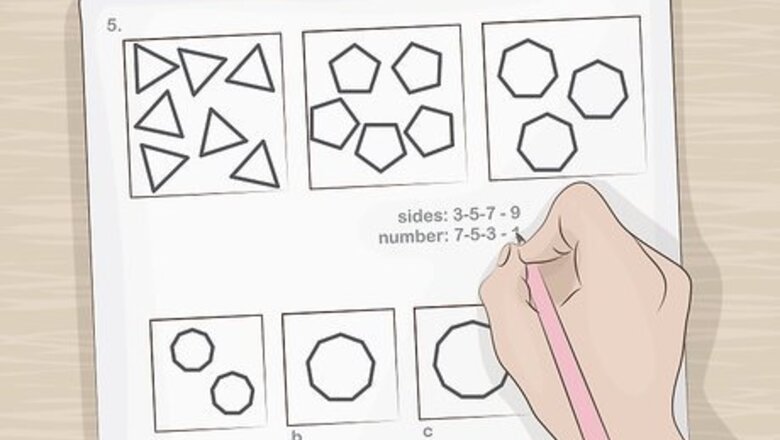
views
Problem Solving Strategies

Evaluate the pattern or shape. Abstract reasoning test questions generally feature a series of patterns or shapes that are all related, and solutions are often simple. Start each question simply by taking inventory of the building blocks of the pattern. Look for predictable changes from one image to the next, taking note of things like: The number of shapes The size of the shapes The number of sides each shape has The shading of each shape The orientation of each shape
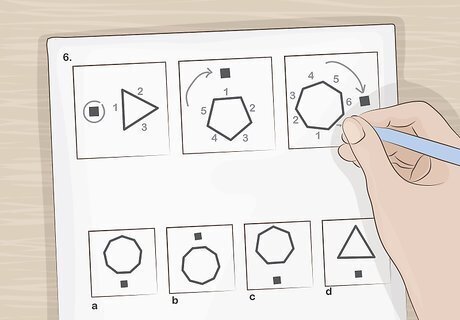
Look for the pattern rules or relationships. The patterns in an abstract reasoning test are dictated by a set of rules or relationships. Once you’ve taken notice of the shapes within a pattern, start looking for the rules that dictate how these shapes change. The items that you noted when evaluating the pattern will often relate to the change in the shapes. For example, the pattern may dictate that the biggest shape in an image has two more sides than the previous image. So the first image may show a triangle, while the second will show a pentagon. Depending on the level of test you are taking, the pattern may have more than one rule governing it. Evaluate each part of the pattern carefully to see if there are multiple rules. Always be prepared for the chance that a pattern may have more than one rule.

Choose the answer that should come next in the pattern. Once you’ve figured out the rule for the pattern, pick the answer that should come next in the pattern sequence. Be sure to look at each answer option carefully, since they are typically designed to look similar. For example, if each shape in a pattern has two more sides than the previous shape, your test may show a triangle, a pentagon, and a septagon. The answer you would choose, then, would be a nonagon, or a polygon with nine sides. If none of the answer choices follow your rule, then you probably have the wrong rule and need to rethink the pattern.
Advance Practice
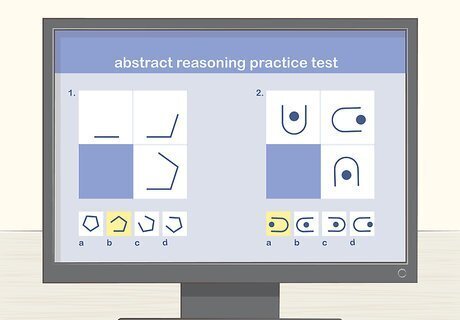
Take an abstract reasoning practice test. You can find these online or in test prep books. Take a few different practice tests from a few different sources to get a broad variety of questions. The more you practice taking the test, the more comfortable you will be with the format. Start by taking a practice test before you start any other test prep. This will give you a baseline you can use to measure improvement. Then, use a different practice test every few days to check your progress. The number of practice tests you should take will ultimately depend on how long you have to prepare for your exam. Since many test takers only have a few days to prepare, they may only have time for a few practice tests. Most practices tests will help prepare you for a range of test levels from basic to advanced.
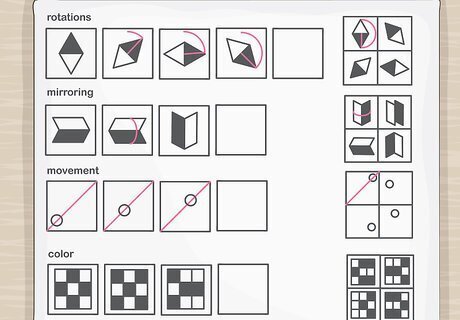
Learn the common types of abstract reasoning exercises. Abstract reasoning tests often use predictable exercises and transformations to determine the test patterns. Sometimes, a test will use just one exercise per pattern, while other times, it may use many exercises with a pattern. Take a look at examples of the different types of patterns to better understand what kind of changes they dictate. Common exercises and transformations include: Clockwise and counterclockwise rotations Mirroring Movement along vertical, horizontal, or diagonal axes Movement by degree intervals, such as 45, 90, 180, etc. Color alternation, generally between black and white

Check website study guides. Unlike the SATs or ACTs, there aren't a lot of books to help you study for an abstract reasoning test. Many test makers and test centers, though, offer online study guides. These guides can help you determine what you should be focusing on as you go through your test prep. If you can, look for a guide put out by the maker of your test or your testing center. These will likely most closely mirror the test you will take. There are some books about passing diagrammatic reasoning tests, but these are generally authored by third parties and aren't put out by major publishers.

Use puzzles to help you practice. If you have at least a few days to prepare, spend a little time each day doing puzzles. These could be traditional jigsaw puzzles or puzzle games like sudoku. Puzzles help engage the same types of thinking that you will need for your abstract reasoning test. Jigsaw puzzles, for example, help you visualize geometric transformations by requiring you to fit puzzle pieces together. Puzzle games likewise call on you to use critical reasoning to find relationships and patterns.
Keeping Calm During the Test
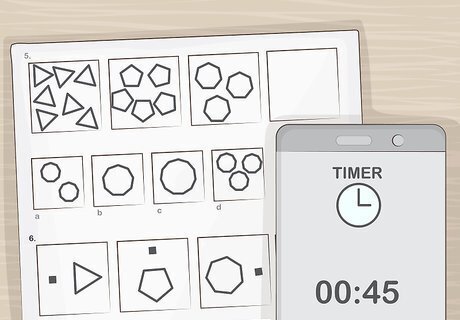
Manage your time during your test. Many abstract reasoning tests are timed. Before you start your test, evaluate the amount of time you have and the number of questions you need to answer. Set a time limit for each question. This will prevent you from spending too long on difficult-to-answer questions. If, for example, you have 30 minutes to complete a 30 question test, your time limit would be a minute per question. You may even bump that down to 45 seconds per question so that you have time to review at the end. Don’t stress about the ones you skip. Once you’ve finished answering the questions that come easier to you, you will be able to go back and tackle the hard ones with your extra time.

Take a deep breath before you start. Abstract reasoning tests can seem difficult because they ask you to use skills you don’t engage every day. Immediately before you start your test, take a few deep breaths, and remind yourself that you have prepared. If you find yourself particularly frustrated with a question, take a deep breath in and skip it. Start the next question with a clear mind, and come back to the difficult question later.

Read all pre-test instructions carefully. Before the timer starts on your test, you will typically be given a set of instructions. These may outline how to select answers, how to navigate the testing software or website, and how to submit your test. Read these fully and completely before you start the clock. Knowing what to expect from the test interface will help you focus on the test itself, rather than worrying about software navigation or how to submit your results.















Comments
0 comment